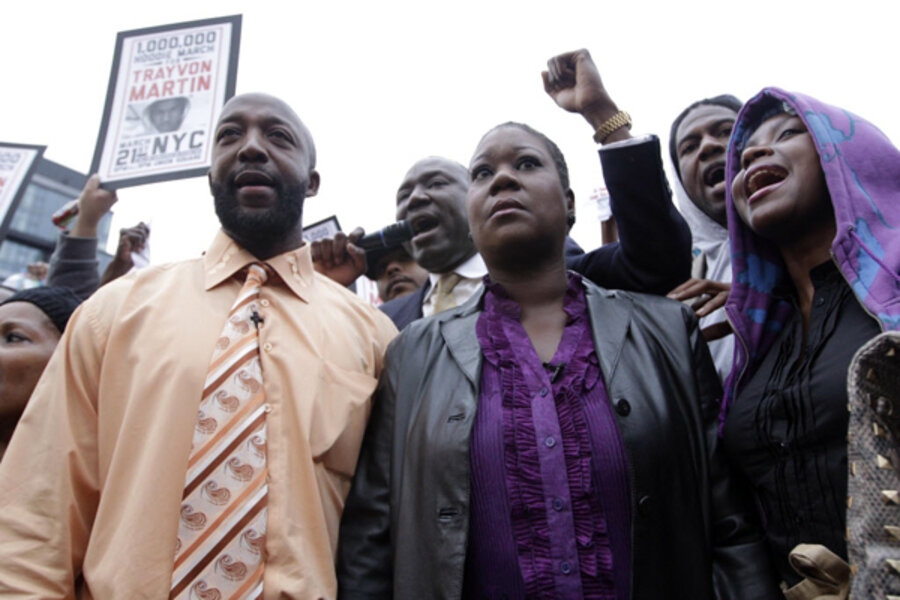Trayvon Martin case shows evolving influence of black community
Loading...
The case of Trayvon Martin is pointing to the important role that that black community has played – both through news outlets and social media – in keeping his death in the public eye.
Several prominent black journalists have been crucial in raising awareness of the killing of the unarmed 17-year-old by a neighborhood watch captain, some experts say. Moreover, influential rappers and actors have used Twitter and other avenues to stoke wider outrage.
The effort shows how the black community is adapting to use new technologies and opportunities to bring their concerns before the nation.
Najee Ali, a Los Angeles-based activist and director of Project Islamic H.O.P.E., says the issue was brought to his attention by the tweets of black celebrities such as Russell Simmons, Spike Lee, and clerics such as the Rev. Al Sharpton. [Editor's note: The original version of this story misidentified the name of Russell Simmons.]
“Black people were not even aware that [Martin] had been shot and killed until Rev. Al Sharpton and other black celebrities started posting it on social media sites such as Twitter and Facebook,” he says.
Lee has tweeted: "America The Beautiful,A Country Where A Black Teenager Can Be Shot And Killed Coming From A 7-Eleven Buying A Ice Tea And A Bag Of Skittles."
Black actress Gabrielle Union has also used Twitter to express her anger: "#TrayvonMartin case has exposed some ppl as monsters...not just Zimmerman but ANY1 who makes excuses 4 a man who kills an unarmed child."
As more blacks – like members of all ethnic groups – gravitate to Twitter, the social-media platform is gaining a greater ability to shape national causes.
"As in our previous research on Twitter use, African Americans and Latinos continue to have high rates of adoption of the service,” according to a Pew Research Center study from 2011. “Fully 25 percent of online African Americans use Twitter at least occasionally, with 11 percent doing so on a typical day."
But the black community's response to the Martin killing has not been only a social-media story.
Artist Jasiri X, an indie rapper from Pittsburgh, went viral with a rap song ending with the words, "the message is only white life is protected in America."
Black journalists have also played a crucial role, says Maurice Hall, chair of the communication department at Villanova University in Philadelphia. He cites four in particular: Trymaine Lee at the Huffington Post; Charles Blow of The New York Times; Eugene Robinson of The Washington Post; and Tulane University professor Melissa Harris-Perry, who has appeared on MSNBC.
He goes so far as to say that the efforts of these journalists have contributed to the US Justice Department opening an investigation Monday.
“These are very prominent mainstream journalists that argued that the case needs to be looked at more closely,” says Professor Hall. “So you had the combination of online and mainstream media that really kept pushing this story in important ways. You can’t pin it to any one thing, of course, but in my observation it is very clear that if it weren’t for these prominent black journalists, this story wouldn’t have been kept in the media and produced the pressure on federal law enforcement to respond.”
Others agree that the rallying of the black community together in support of Martin played a crucial role in keeping the topic front and center.
“I would say in the Trayvon Martin case, if it weren’t for the black voices taking to the streets and getting visits from the attorneys and staying involved, that the wider media would not have thought this newsworthy,” says Donald Tibbs, a professor at Drexel University's Earle Mack School of Law in Philadelphia and author of “From Black Power to Prison Power.”
The Martin case is a perfect example of the influence of the black community on national media coverage, says Derede McAlpin, vice president of Levick Strategic Communications in Washington. She says it parallels the case of the Jena Six of 2006, in which six black teens were arrested for serious offenses while their non-minority counterparts received different treatment.
“The [Jena Six] case was largely ignored by the US national media. The Town Talk and The Jena Times covered the story from its inception,” says Ms. McAlpin. “But the case didn’t reach a national level until African-American bloggers and [black] media reported on the issue, which resulted in the mobilization of a nationwide network of supporters, civil rights activists, and community groups.”





